We all know the Vikings – history’s most feared and famous globetrotting pillagers. Our endless fascination with Norse prehistory makes them the ideal subject for the TV drama series that bears their name. But who were the real-life Vikings?
First, lets clear up what we mean by Vikings…or at least try. Some scholars argue that ‘Vikings’ refers specifically to the sea-faring warriors who went voyaging overseas claiming lands for Scandinavian rule.
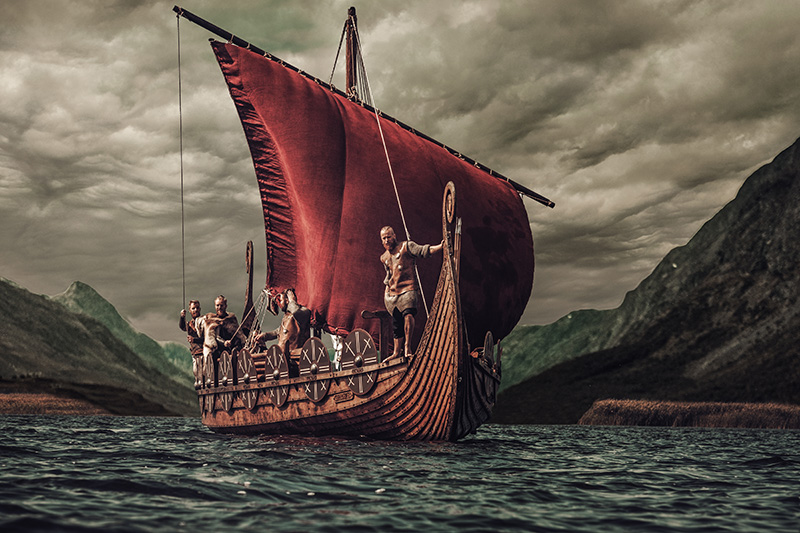
Others believe that Vikings can rightly be used to mean all Norsemen of the Viking age, widely agreed to be between around 800 and 1050 CE.
No matter how you choose to define them, all of the characters we present here did their fair share of voyaging, plundering and pillaging. Therefore, in our eyes, they’re definitely Vikings!
Table of Contents
Ragnar Lodbrok
A controversial character, if legend is to be believed Ragnar Lodbrok (Ragnar Shaggy-Trousers) led raids against the Franks and the Anglo-Saxons, was married three times and fathered at least six children. Whilst this is far from impossible, scholarly opinion is divided.
The true story will never be known but it’s believed that Ragnar may be a composite of various figures. Either that, or he is a character of part truth and part invention. Most of his sons are believed to be true historical figures and most of the things he supposedly did were things that happened!
Ragnar met his death in England when he attacked with just two ships. He was trying to prove himself against his sons who were rising through the ranks of bloodthirstiness!
After a little initial success, he was eventually captured by King Ælla of Northumberland and thrown into a pit of snakes as, I guess, was the custom of the time.
Ragnar is the central character in the first four seasons of the History Channel’s hit series Vikings…and it’s clear to see why!
The Sons of Ragnar
Another matter of contention is whether ‘sons of Ragnar’ means literally those fathered by him or simply – Sparta-style – that many noble warriors of the time called themselves Sons of Ragnar in tribute.
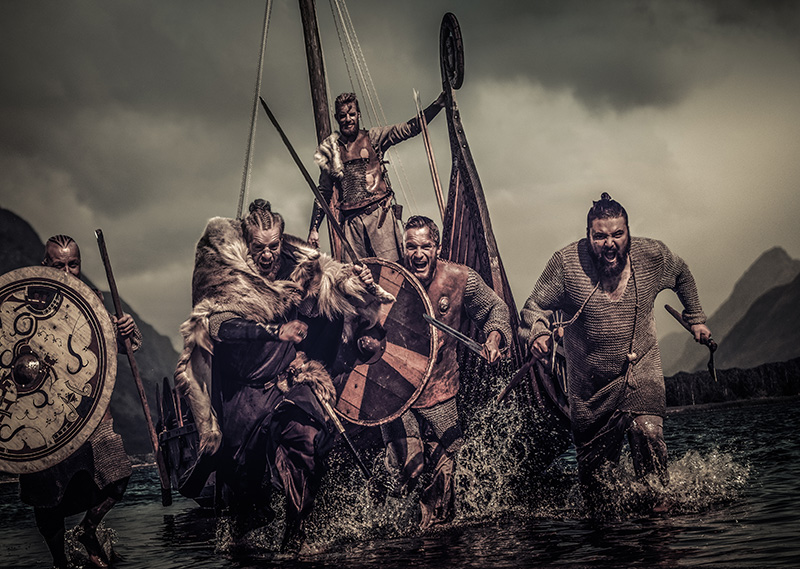
One thing that we think we know is that several of these sons gathered together to form the Great Heathen Army. This army was formed to conquer Anglo-Saxon England and avenge Ragnar’s death.
Ragnar’s sons were:
- Ivar the Boneless, a man famous for turning brittle bone disease into a fearsome nickname
- Bjorn Ironside, a warrior who once tried to become the new Roman Emperor
- Halfdan Ragnarsson, the first Viking King of Northumberland
- Sigurd Snake-in-the-eye, a man with a snake in his eye…or at least it looked like it
- Ubba Ragnarsson, ‘the other one’ about whom history has very little to say
There’s also mention of one called Hvitserk – White Shirt – but as he and Halfdan are never mentioned in the same place, many believe that simply to have been a nickname.
So, Ivar and Halfdan were primarily responsible for taking over much of England. They started with Northumberland, as that was where their father had been killed, then Halfdan became King there and Ivar headed to East Anglia where he had little trouble taking over.
Mercia fell next and if it hadn’t been for plucky King Alfred, who managed to defend his Kingdom of Wessex through war, diplomacy and money, they might have managed to secure the whole of England rather than simply the three kingdoms of Mercia, East Anglia and Northumberland.
Harald Bluetooth
As King, Harald Bluetooth is not known for many great acts of daring, courage or warfare.
One thing he is known for is that during his reign, the name Denmark was used for the first time, on the Jelling rune stones. He was the first to rule ‘all of Denmark’ and as such is considered to have brought Denmark together.
His legacy includes introducing Christianity to Denmark. His name, however, will live on in a much more modern sense. It was chosen to be the name of a wireless communications protocol that now connects most of our devices together.
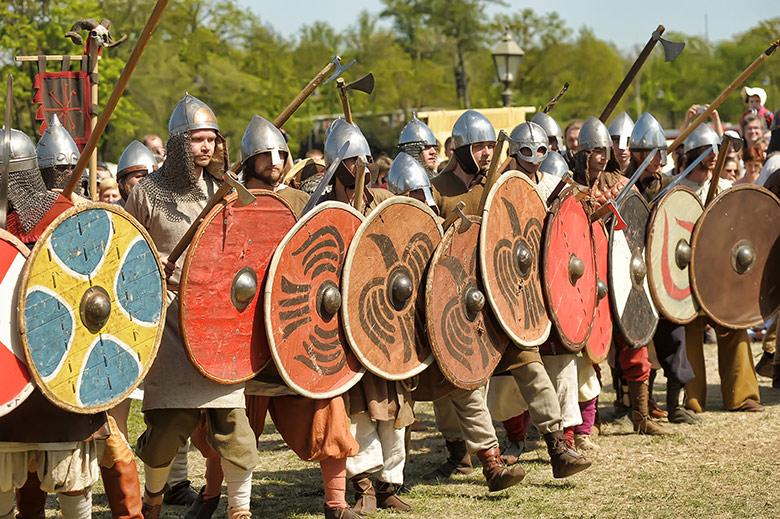
The designers chose the name specifically because of the ‘unification’ context of his legacy. Bluetooth was intended to unite all computer devices! The Bluetooth symbol is a combination of the runes for H and B.
Sweyn Forkbeard
Sweyn was Harald Bluetooth’s son and apparently had a much more expansionist outlook than his father. One thing he is believed to have done is depose his own father from the throne of Denmark!
Sweyn spent much of his later years trying to take over England. This was in revenge for the St Brice’s Day massacre where King Æthelred the Unready ordered the execution of all Danes living in England. This itself was a reaction to the repeated raids of England by Danes every year since the Anglo-Saxons had reclaimed their thrones and expelled the Viking rulers.
He attempted from 1002, on and off, to 1012 before finally meeting with success in 1013. Victory was hardly sweet as he only ruled England for five weeks before his death! His successor was named as Cnut who finally took the throne after a two-year rebellion by the deposed King Æthelred.
Cnut the Great
You may have heard of Cnut, often styled as Canute, in the story of King Canute and the Tide.
The story is often told that the foolhardy Canute, believing himself to be all-powerful, placed his throne by the sea and commanded the tide to stop. In actual fact, the original story was quite the opposite.
Canute took his throne by the sea precisely to demonstrate to his fawning courtiers that the secular powers of men, even Kings, were nothing in the face of the powers of God.
Described by one historian as ‘the most effective king in Anglo-Saxon history’, Cnut managed to combine the typical brutality with cultural exchanges in an attempt to keep his Kingdoms happy.
Styled as King of all England and Denmark and Norwegians and some of the Swedes’, Cnut managed this quite well and is remembered favourably in the historical record.
Harald Hardrada
The final chapter in what we might call ‘The English Saga’, Harald Hardrada was the last Viking to lay claim to the English throne. Cnut and his heirs had ruled from 1016 to 1042 before coming to the end of the line when power returned to the Anglo Saxons in the form of Edward the Confessor.
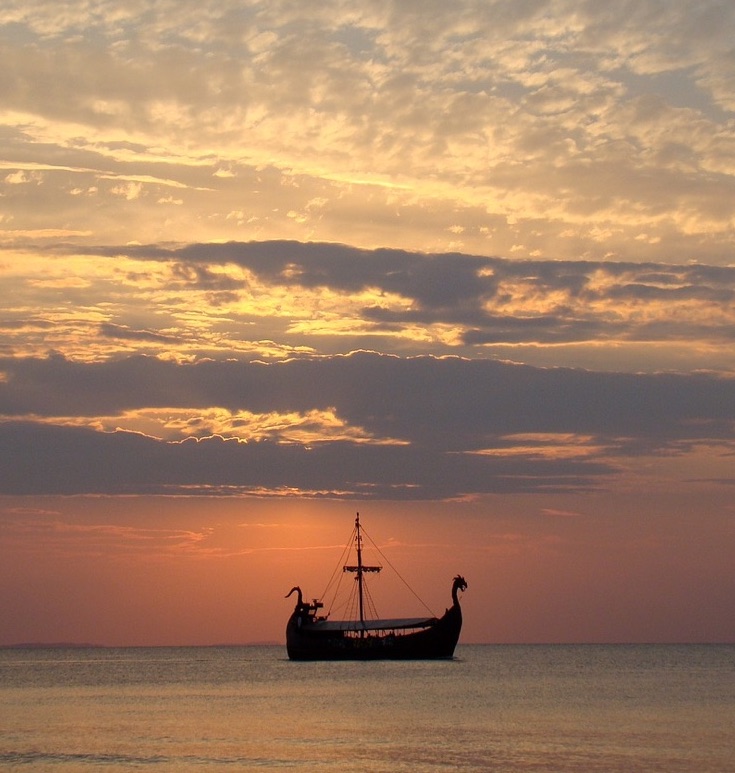
Edward promised the throne to both William of Normandy and Harold Godwinson. In 1066, Edward died and Harold ascended to the throne.
William of Normandy immediately raised an army but so too did Harald Hardrada, King of Norway, who was invited by Godwinson’s estranged brother Tostig to claim the throne.
Hardrada invaded but Godwinson managed to defeat him at the battle of Stamford Bridge, shortly before William invaded from Normandy.
1066, with the death of Harold Godwinson and Harald Hardrada, is said to mark the end of both Anglo-Saxon Britain and The Viking Age of Scandinavia.
Rollo of Normandy
Rollo, or Rolf, was a Viking who became the first ruler of Normandy in Northern France. Having seized Rouen and practically razed it to the ground, the Vikings entered an agreement with the King of France. Over time they built up their area until they ruled most of the modern-day region of Normandy.
Rollo is remarkable mostly for his descendants. One of his great-great-great-grandsons was William of Normandy who took the English throne in 1066. He is therefore an ancestor of both the modern British Royal Family and, indeed, most of the monarchies, both existing and abolished, throughout Europe.
Rollo’s nickname, Gaange Rolf, or Walking Rolf, comes from the fact that he was so large in his later years that no horse could bear him and he had to travel by foot!
Erik the Red
His reputation is probably one of the most bloodthirsty among all of the Vikings. The son of Thorvald, Erik the Red is chiefly remembered for being the Viking who founded the first settlement in Greenland.
His father Thorvald left Norway with his young son Erik, around 10 years old, because of ‘some killings’. They settled in Northwest Iceland and lived a fairly peaceful life – for Vikings – until Thorvald died when Erik was around 30 years old.
A couple of years later, Erik’s slaves caused a landslide on a neighbouring farm owned by Valthjof. His friend, Eyiolf the Foul killed the slaves in retaliation so Erik killed Eyiolf and Holmgang-Hrafn. This caused his banishment from Haukadal so he moved to Oxney.
When building his home, he asked Thorgest to look after some ornamental beams of sentimental value. When he went to collect them, they were nowhere to be found so he took Thorgest’s beams instead. Thorgest chased him so Erik killed him along with ‘a few other men’. A ruling was made to banish Erik for three years.
Erik used this time to head out on the sea towards a land that had been discovered but not settled. After sailing up the coast and finding a suitable area for settlement, Erik established a base and called it Greenland, figuring that such a nice name would make more settlers want to join him!
After his exile was over he returned to Iceland with tales of Greenland and convinced many more people to join him. Over the years, Erik became respected and wealthy as the leader of Greenland. While this tale may not sound all that bad, just think how much of a badass you need to be to be banished, twice, by other Vikings!
Bjarni Herjolfsson
You may have heard about Erik’s son Leif. He was a much milder man. He converted to Christianity – something his father steadfastly refused – as well as discovering North America.
You can read all about that here so there’s no point repeating it.
But Leif Eriksson didn’t truly discover North America from Europe. Bjarni Herjolfsson had that distinct honour. He was sailing for Greenland and missed – understandable given the technology they had at the time – and spied the land that came to be known as Vinland.
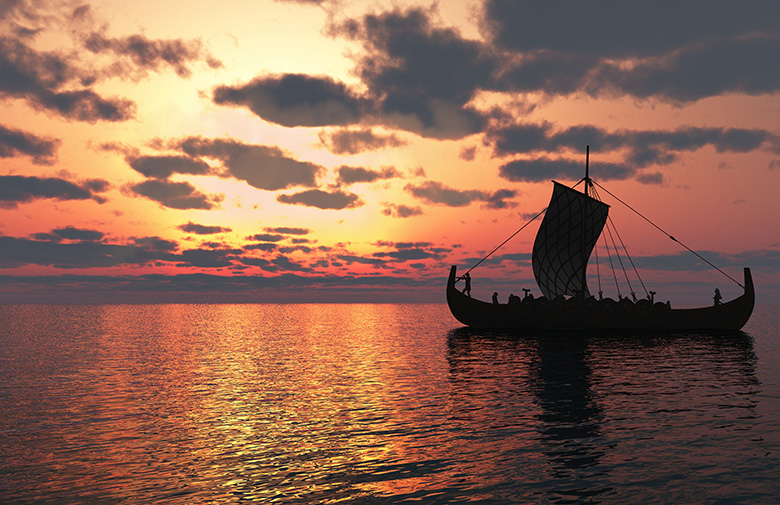
Rather than settle, Bjarni simply turned around and headed back to his intended Greenland – no easy feat considering it’s one of the largest land masses on Earth and he’d already missed it once! – leaving Erik the Red’s son Leif to take the glory of settling North America.
Olav Tryggvasson
Son of Tryggvi Olavsson, Olav Tryggvasson not only continued the family tradition by calling his son Tryggvi but also the first King Olav of Norway. He was also great-grandson of Harald Fairhair, the first King of Norway.
Olav lived a very convoluted life in which his mother fled his father’s killers, eventually ending up selling the boy into slavery only for him to be rescued by Kievan Rus. He found his way to Wendland where he married Geira and helped her reclaim some of her lands. When she died, he went a-plundering all the way to the Hebrides and beyond. On one of the Isles of Scilly he found a Seer who told him that he would convert to Christianity.
After that he visited England to marry the King of Dublin’s sister. They spent half their time in England and half in Ireland until, miraculously, word reached Norway that there was a man of Norwegian Royal blood. Unpopular King Jarl Haakon sent someone to bring him forth, to try to increase his standing, but instead, by the time he arrived, Haakon was in hiding and Olav was greeted as King!
Olav set up his seat of government in Trondheim – there is a statue of him in the city – and spent much of his reign converting people to Christianity. He baptized Leif Erikson before sending him to convert the rest of Greenland and, during his time, converted the Orkney Islands too.
Olav Haraldsson
Under other circumstances, King Olav II would be forgotten. As King he was fairly unsuccessful and much of his power seems to have been derived from Cnut the Great. He was a great-great-great-grandchild of Harald Fairhair and, after his father died, the half-brother of Harald Hardrada – future King of Norway and almost-King of England.
During his life he was known as Olav the Big, Olav the Stout, Olav the Fat – not generally words of veneration! Within a year of his death, he was canonized by Bishop Grimkell and became St Olav. He was rapidly adopted as the patron saint of Norway. The cult of Olav helped complete the work to Christianize Norway.
Throughout his reign, Olav had worked towards the conversion of the country. It’s difficult to assess his success in life because many parts of the country had already converted. None of the sees he established were permanent. It’s also hard to see Olav’s brutal and violent manner as being that of a Christian that we might think of today.
Regardless of his success in life, as St Olav, and with the posthumous title of Rex Perpetuus Norvegiae (Perpetual King of Norway) Olav II certainly plays an important role in the cultural fabric of Norway.
Erik Bloodaxe
We're not done yet! Erik Bloodaxe, born Eirik Haraldsson around 895, was a notorious Viking king and the son of King Harald Fairhair and Queen Ragnhild Ericsdatter. His royal birth gave him an edge over his numerous siblings, eventually leading to his co-regency with his father.
His short reign as King of Norway was marked by violence and tyranny, earning him his fearsome nickname after a brutal campaign against his brothers. His rule lasted only a few years before he was expelled, deemed a tyrant.
Later, Erik became King of Northumbria, England, for a period, evidenced by coins bearing his name. His death around 954 led to his wife Gunnhild's machinations to secure the throne for their son, Håkon.
The legacy of Erik Bloodaxe is a blend of historical and legendary elements, with his life and posthumous reputation forming the basis of various sagas and even a historical fantasy novel by Poul Anderson.
My favourite Viking who didn’t make it into this story? Einar Buttered-Bread. Not for any great reason other than I’m intrigued by how he got his nickname. No source seems to know!


As we have juzt passes suttende mai, I was wondering about the norwegian who killed the king of sweden that led to norways indepenence. Can you tell the story ? The swedes decided a noreegian farmer wasn’t important enough to kill a king, so they said one of the kings own men did the deed. King Karl is entombed in the cathedral in stockholm, if the Swedes would allow a postmortem the answer would finally be clear
The Viking era continued for a couple of hundred years.
BIRKEBEINER – THE LEGEND
Extracted from the Saga’s
By
Kaare Askildt
Civil war raged in Norway around the year 1200. War parties lead by their chieftains fought for control of their local districts and the country. The Birkebeiner’s leader, King Sverre had acquired most of the country when he died in 1202. But the Baglers who were supported by the Catholic Church, had control of the southern half of the country.
Haakon Haakonson was born out of wedlock in Østfold in the spring of 1204 to Inga of Varteig, who worked as a chambermaid and cook for one of his father’s chieftains. His father Haakon Sverreson died New Years Day in 1204 in battle in Scotland and was buried on the Isle of Skye, and his illegitimate son and heir to the throne was being hunted by the Baglers who wanted the Prince out of the way. Haakon had to be protected and a party of Birkebeiner warriors fled with the toddler to bring him to their friend King Inge in Nidaros (Trondheim). King Inge ruled Norway in the absence of Haakon Sverreson, and until a new king was found and crowned.
They arrived in Hamar Christmas Eve in 1205 and continued on to a little farm by Lillehammer, where they were hiding over Christmas. They did not dare take the normal route up through Gudbrandsdalen, but skied over two mountain ranges to Rena in Østerdalen. They suffered through snow storms and bitterly cold weather.
Two of their best skiers Torstein Skjevla and Skjervald Skrukka skied ahead with the little child, and arrived safely in Rena. The local farmers greeted them with food and lodging. The rest of the Birkebeiners caught up with them in Rena. The loyal farmers provided them with horses and a sleigh, and sent them on their way north to Nidaros (Trondheim).
We can envision the two Birkebeiners urging their way forward across the mountains through snowstorms and bitterly cold weather, without any thought of turning back or giving up. They gave all they had of courage, strength and raw will to bring the little Prince to safety.
Haakon Haakonson was crowned as King of Norway and ended the civil war. Norway prospered and grew under his reign. He was King of Norway from 1217 to his death in 1263.
The Birkebeiners (Birchbarkleggers) got their name from wrapping and tying birch bark around their legs from the knees down, similar to gaiters. This kept the snow out, and protected their legs in battle.
They used one long and one short ski and only one pole. The long ski for gliding and the short ski for pushing. They would alternate the skis from one leg to the other. The pole would also serve as a weapon. It had a pointed end and a flared end. They pushed the flared end into the snow to propel themselves forward. The flared end was also detachable and served as a drinking vessel.